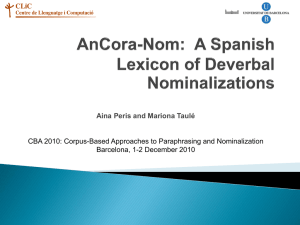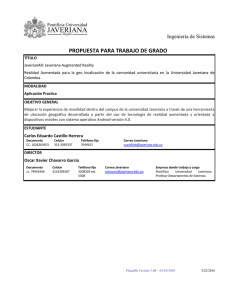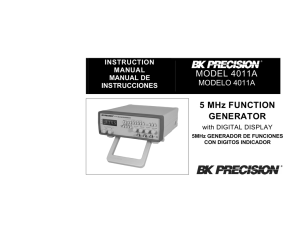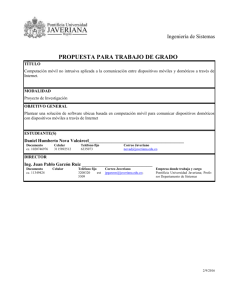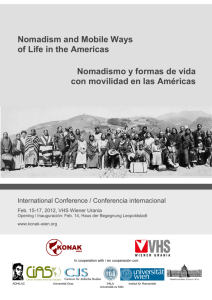citel04752s02
advertisement
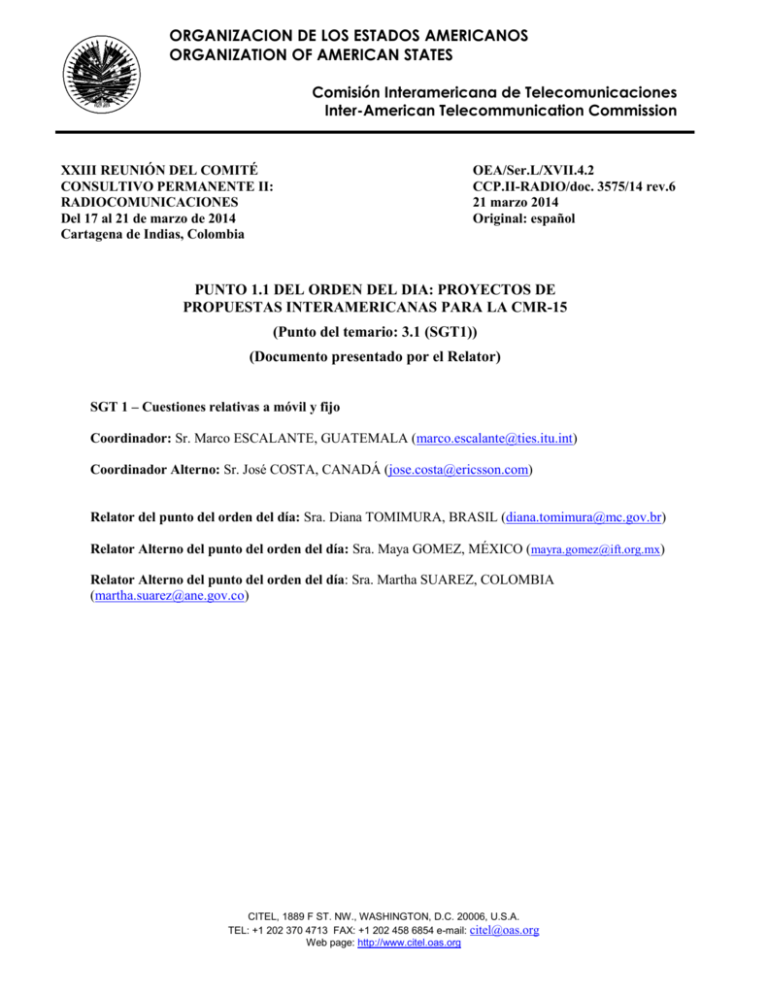
ORGANIZACION DE LOS ESTADOS AMERICANOS ORGANIZATION OF AMERICAN STATES Comisión Interamericana de Telecomunicaciones Inter-American Telecommunication Commission XXIII REUNIÓN DEL COMITÉ CONSULTIVO PERMANENTE II: RADIOCOMUNICACIONES Del 17 al 21 de marzo de 2014 Cartagena de Indias, Colombia OEA/Ser.L/XVII.4.2 CCP.II-RADIO/doc. 3575/14 rev.6 21 marzo 2014 Original: español PUNTO 1.1 DEL ORDEN DEL DIA: PROYECTOS DE PROPUESTAS INTERAMERICANAS PARA LA CMR-15 (Punto del temario: 3.1 (SGT1)) (Documento presentado por el Relator) SGT 1 – Cuestiones relativas a móvil y fijo Coordinador: Sr. Marco ESCALANTE, GUATEMALA (marco.escalante@ties.itu.int) Coordinador Alterno: Sr. José COSTA, CANADÁ (jose.costa@ericsson.com) Relator del punto del orden del día: Sra. Diana TOMIMURA, BRASIL (diana.tomimura@mc.gov.br) Relator Alterno del punto del orden del día: Sra. Maya GOMEZ, MÉXICO (mayra.gomez@ift.org.mx) Relator Alterno del punto del orden del día: Sra. Martha SUAREZ, COLOMBIA (martha.suarez@ane.gov.co) CITEL, 1889 F ST. NW., WASHINGTON, D.C. 20006, U.S.A. TEL: +1 202 370 4713 FAX: +1 202 458 6854 e-mail: citel@oas.org Web page: http://www.citel.oas.org Contenido Contenido ...................................................................................................................................................................... 1 1. FREQUENCY RANGES BETWEEN 1-2 GHz.................................................................................................... 2 1.1. BAND 470-698 MHz ................................................................................................................................... 2 ANTECEDENTES: ............................................................................................................................................... 2 PROPOSAL: .......................................................................................................................................................... 3 2. FREQUENCY RANGES BETWEEN 2-3 GHz.................................................................................................... 6 2.1. BAND 2 025-2 110 MHz and 2 200-2 290 MHz ......................................................................................... 6 3. FREQUENCY RANGES BETWEEN 3-6 GHz.................................................................................................... 7 3.1. BAND 3400-3600 MHz (Fuente: Documento 3574-1-1r1) ......................................................................... 7 ANTECEDENTES: ............................................................................................................................................... 8 3.2. BAND 3400-4200 MHz (Fuente: Documentos 3471 y 3556p1) ................................................................. 9 CONSIDERACIONES GENERALES .................................................................................................................. 9 CONSIDERACIONES PARTICULARES ......................................................................................................... 10 PROPUESTA: ..................................................................................................................................................... 10 1.1. BANDA 3 600 - 4 200 MHz .......................................................................................................................... 11 CUESTIONES: ........................................................................................................................................................ 11 PROPUESTA: ......................................................................................................................................................... 12 3.3. BANDA 5850-6425 MHz .......................................................................................................................... 13 CUESTIONES: .................................................................................................................................................... 13 Propuesta: .................................................................................................................................................................. 15 ARTICULO 5 ............................................................................................................................................................. 15 106738192 16.02.16 1 Agenda Item 1.1: to consider additional spectrum allocations to the mobile service on a primary basis and identification of additional frequency bands for International Mobile Telecommunications (IMT) and related regulatory provisions, to facilitate the development of terrestrial mobile broadband applications, in accordance with Resolution 233 (WRC-12); 1. FREQUENCY RANGES BETWEEN 1-2 GHz 1.1. BAND 470-698 MHz ANTECEDENTES: Mobile broadband access has become a key driver of global economic growth, job creation and competitiveness. In developing countries, where mobile wireless is often the only means to achieve ubiquitous broadband access, it has become an economic imperative. Africa, for example, has experienced the highest growth, with mobile-broadband penetration increasing from 2% in 2010 to 11% in 2013.1 This dramatic growth in mobile-broadband traffic, with mobile video comprising over 50% and growing2, has resulted in an acute need for additional spectrum. The 2012 World Radiocommunication Conference recognized this need and adopted WRC-15 Agenda Item 1.1, in an effort to address the looming spectrum shortage for the mobile broadband services. In considering the global spectrum requirements under WRC-15 Agenda Item 1.1, it is important to acknowledge, as reflected in recognizing d of Resolution 233 (WRC-12), that the spectrum below 1 GHz is exceptionally suited for mobile broadband applications. In particular, the unique propagation characteristics of the bands below 1 GHz allow for wider area coverage which in turn requires less infrastructure and facilitates service delivery to rural or sparsely populated areas, as reflected in recognizing c of Resolution 233 (WRC-12). The 470-806/862 MHz frequency range is allocated to the broadcasting service on a primary basis in all three Regions and used predominantly for the delivery of broadcast television. Broadcasting continues to be an important service as broadcast television stations provide information and video programming that is responsive to the needs and interests of the communities they serve. Moreover, broadcast television itself continues to evolve to keep pace with technological and marketplace changes. Many television broadcasters now pursue a three-screen approach, sharing their programming online and on mobile devices, in addition to providing it over the air. In fact, providing mobile access to broadcast television content is a compelling factor in the development of future DTTB systems. In this regard, efforts are also underway in the United States and worldwide to develop the next generation of terrestrial broadcast systems. One such initiative, the Future of Broadcast Television Initiative (FoBTV) is a worldwide effort to define requirements, recommend technologies and request standardization for such systems. A key element of any next generation broadcast system recognized by the FoBTV Initiative is: “The importance of mobility in future broadcast systems and the desire for mobile, handheld and portable devices to be capable of working across borders …”. Within the United States, work on the development of these next generation standards has already begun. “The Advanced Television Systems Committee (ATSC) has received 11 initial proposals from 20 organizations for the Physical Layer of the new “ATSC 3.0” broadcast television standard.” “A primary goal of the ATSC 3.0 Physical Layer is to provide TV service to both fixed and mobile devices. Key considerations include 1 http://www.itu.int/en/ITU-D/Statistics/Documents/facts/ICTFactsFigures2013-e.pdf 2 http://www.cisco.com/en/US/solutions/collateral/ns341/ns525/ns537/ns705/ns827/white_paper_c11-520862.html 106738192 16.02.16 2 efficiency and robust service, increased data rates to support new services such as Ultra High-Definition services, and enabling a smooth transition from existing systems for both broadcasters and consumers.”3 The importance of broadcasting in emergencies has been recognized and highlighted in a recent draft ITU Report.4 As stated in this report, “television broadcasting is a critically important medium for information dissemination to the public in times of emergencies. The intrinsic one-to-many broadcast architecture and the geographic diversity of terrestrial broadcast transmission facilities provide high service reliability during crises of all types. … The case studies in this report represent only a few of countless examples that attest to the global importance of terrestrial broadcasting, helping to protect and save lives during local, national and international emergencies.” 5 Potential interference between broadcasting and mobile operations also needs to be taken into account. The protection of the broadcasting service is an important consideration. Preliminary studies submitted to ITU-R Joint Technical Group 4-5-6-7 indicate that co-frequency sharing in the UHF band between IMT and DTTB may require significant cross-border separation distances on a case-by-case basis. In this regard, the United States emphasizes the application of No. 9.21, which would require explicit coordination agreement for implementation of mobile systems. To address these interference concerns, the United States proposes the mandatory application of No. 9.21, which would require explicit coordination agreement for implementation of mobile systems. Recognizing the growing need for mobile spectrum below 1 GHz, the current deployment and future development of broadcasting systems, and the differing national priorities of the member states as regards UHF broadcasting, it is necessary for WRC-15 to adopt a regulatory solution that would: (a) Enable administrations to preserve and protect broadcasting and other services in the UHF range, (b) Consider ways to facilitate the development of future broadcasting systems, and (c) Allow administrations flexibility to address the mobile spectrum shortage consistent with their domestic requirements. To achieve these objectives, the United States proposes modifications to the Radio Regulations that would add an allocation to the mobile services and identification for IMT in the range 470-694/698 MHz except for the 608-614 MHz band in Region 2. The United States also proposes retention of the primary allocation to the Broadcasting Service in the 470-890 MHz frequency range, including the mandatory application of No. 9.21, which would ensure that the existing services, such as broadcasting, maintain coordination priority (i.e., remain super-primary) vis-à-vis IMT systems. PROPOSAL: ARTICLE 5 Frequency allocations Section IV – Table of Frequency Allocations (See No.2.1) MOD DIAP/1.1/1 Support: Canada, United States of America 3 http://atsc.org/cms/ 4 www.itu.int/go/ITU-R/RWP6A-2013 5 See, Proposed Draft New Report on the Importance of Terrestrial Broadcasting in Providing Emergency Information to the Public, Document 6/156-E, Document 6A/301-A, 28 October 2013, at p. 12. 106738192 16.02.16 3 460-890 MHz Allocation to services Region 1 470-790 BROADCASTING MOBILE ADD 5.317A, ADD 5.YYY Region 2 470-512 BROADCASTING Fixed MOBILE ADD 5.317A, ADD 5.YYY Region 3 470-585 FIXED MOBILE ADD 5.317A, ADD 5.YYY BROADCASTING 5.291 5.298 512-608 BROADCASTING MOBILE ADD 5.317A, ADD 5.YYY MOD 5.297 608-614 RADIO ASTRONOMY Mobile-satellite except aeronautical mobile-satellite (Earth-to-space) 614-698 BROADCASTING Fixed MOBILE ADD 5.317A, ADD 5.YYY 5.149 5.291A 5.294 5.296 5.300 5.304 5.306 5.311A 5.312 5.312A 790-862 FIXED MOBILE except aeronautical mobile 5.316B MOD 5.317A BROADCASTING 5.312 5.314 5.315 5.316 5.316A 5.319 585-610 FIXED MOBILE ADD 5.317A, ADD 5.YYY BROADCASTING RADIONAVIGATION 5.149 5.305 5.306 5.307 610-890 FIXED MOBILE 5.313A MOD 5.317A ADD 5.YYY BROADCASTING 698-806 MOBILE 5.313B MOD 5.317A, BROADCASTING Fixed MOD 5.293 5.309 5.311A 806-890 FIXED MOBILE MOD 5.317A BROADCASTING 862-890 FIXED MOBILE except aeronautical mobile MOD 5.317A BROADCASTING 5.322 5.319 5.323 5.317 5.318 5.149 5.305 5.306 5.307 5.311A 5.320 Reasons: Globally harmonized allocations to the mobile service in the 470-698 MHz frequency range would enable introduction of innovative broadband services while preserving access to spectrum for the existing services, such as broadcasting. A new allocation to the mobile service would provide 106738192 16.02.16 4 administrations with the flexibility to maximize spectrum utilization. Under the proposed allocation arrangements, administrations may continue to operate existing services, such as broadcasting, or utilize portions of the UHF band for the implementation of new mobile broadband applications, such as IMT, as they deem appropriate based on their domestic priorities, taking into account potential interference considerations. MOD DIAP/1.1/2 Support: Canada, United States of America 5.317A Those parts of the band 470-960 MHz which are allocated to the mobile service on a primary basis are identified for use by administrations wishing to implement International Mobile Telecommunications (IMT) – see Resolutions 224 (Rev.WRC-12) and 749 (Rev.WRC-12), as appropriate. This identification does not preclude the use of these bands by any application of the services to which they are allocated and does not establish priority in the Radio Regulations. (Rev. WRC-15) Reasons: Globally harmonized allocations to the mobile service in the 470-960 MHz frequency range would enable introduction of innovative broadband services, such as IMT, while preserving access to spectrum for the existing services, such as broadcasting. The new allocation to the mobile service would provide administrations with the necessary flexibility to maximize spectrum utilization consistent with their domestic timetables, requirements and objectives. MOD DIAP/1.1/3 Support: Canada, United States of America 5.293 Different category of service: in Canada, Chile, Cuba, the United States, Guyana, Honduras, Jamaica, Mexico, Panama and Peru, the allocation of the bands 470-512 MHz and 614-806 MHz to the fixed service is on a primary basis (see No. 5.33), subject to agreement obtained under No. 9.21.In Argentina and Ecuador, the allocation of the band 470-512 MHz to the fixed service is on a primary basis (see No. 5.33), subject to agreement obtained under No. 9.21. (Rev. WRC 15) Reasons: Consequential change. footnote. Proposed allocation to Mobile service supersedes allocation(s) by MOD DIAP/1.1/4 Support: Canada, United States of America 5.297 Additional allocation: in Canada, Costa Rica, Cuba, El Salvador, the United States, Guatemala, Guyana, Honduras, Jamaica and Mexico, the band 512-608 MHz is also allocated to the fixed service on a primary basis, subject to agreement obtained under No. 9.21. (Rev. WRC15) Reasons: Consequential change. Proposed allocation to Mobile service supersedes allocation(s) by footnote ADD DIAP/1.1/5 Support: Canada, United States of America 106738192 16.02.16 5 5.YYY The operation of stations in the mobile service for the implementation of International Mobile Telecommunications (IMT) in the frequency band 470-694 MHz in Region 1, in 470-608 MHz and 614698 MHz in Region 2, and in 470-698 MHz Region 3 shall be subject to agreement obtained under No. 9.21. (WRC-15) Reasons: The application of No. 9.21 requires the explicit agreement of the affected administrations. The mandatory application of No. 9.21, therefore, would ensure the protection of incumbent systems such as broadcasting vis-à-vis IMT systems. The above provision would also facilitate the development of future broadcasting systems. Global harmonization is an important factor for broadcast television services and will become even more so as mobile broadcast services are implemented that will facilitate the use of portable television broadcast devices. 2. FREQUENCY RANGES BETWEEN 2-3 GHz 2.1. BAND 2 025-2 110 MHz and 2 200-2 290 MHz ANTECEDENTES: The 2012 World Radiocommunication Conference (WRC-12) recognized a need for additional radio spectrum to support the increasing mobile data traffic, and placed consideration of additional spectrum allocations for terrestrial mobile broadband applications on the agenda for WRC-15. CPM-15/1 tasked Working Party 5D (WP5D) to provide frequency ranges to Joint Task Group 4-5-6-7 (JTG) that would be suitable for IMT operations. WP5D included the ranges 2 025-2 110 MHz and 2 200-2 290 MHz among the many frequency ranges below 6 GHz provided to the JTG. WRC-12 resolved to invite the ITU-R to carry out sharing and compatibility studies between IMT systems and systems of services already having allocations in potential candidate bands and in adjacent bands, as appropriate, taking into account the current and planned use of these bands by the existing services. CPM-15/1 tasked the JTG with carrying out the studies. Studies submitted to the JTG that assessed the feasibility for accommodation of IMT long-term evolution (LTE) systems in both the 2 0252 110 MHz and 2 200-2 290 MHz frequency ranges have shown that sharing is not feasible with existing services in these frequency ranges. These studies reaffirmed earlier ITU studies that resulted in the adoption of No. 5.391 at WRC-97, which prohibits high-density mobile systems from operation within these frequency bands. PROPUESTA: ARTICLE 5 Frequency allocations Section IV – Table of Frequency Allocations (See No. 2.1) NOC DIAP/1.1/6 Support: Mexico, United States of America 1 710-2 170 MHz 106738192 16.02.16 6 Allocation to services Region 1 … 2 025-2 110 Region 2 Region 3 SPACE OPERATION (Earth-to-space) (space-to-space) EARTH EXPLORATION-SATELLITE (Earth-to-space) (space-to- space) FIXED MOBILE 5.391 SPACE RESEARCH (Earth-to-space) (space-to-space) 5.392 … Reasons: ITU-R studies have shown that sharing is not feasible between International Mobile Telecommunications (IMT) systems and systems of incumbent services in the 2 025-2 110 MHz band. ARTICLE 5 Frequency allocations Section IV – Table of Frequency Allocations (See No. 2.1) NOC DIAP/1.1/6 Support: Mexico, United States of America 2 170-2 520 MHz Allocation to services Region 1 Region 2 Region 3 … 2 200-2 290 SPACE OPERATION (space-to-Earth) (space-to-space) EARTH EXPLORATION-SATELLITE (space-to-Earth) (space-to- space) FIXED MOBILE 5.391 SPACE RESEARCH (space-to-Earth) (space-to-space) 5.392 … Reasons: ITU-R studies have shown that sharing is not feasible between International Mobile Telecommunications (IMT) systems and systems of incumbent services in the 2 200-2 290 MHz band. 3. FREQUENCY RANGES BETWEEN 3-6 GHz 3.1. BAND 3400-3600 MHz (Fuente: Documento 3574-1-1r1) 106738192 16.02.16 7 ANTECEDENTES: La Administración de Brasil ha estado realizando estudios para cumplir con el punto 1.1 del orden del día en diversas bandas, y ha podido concluir su consideración del la banda de 3,4-3,6 GHz. La CMR-07 ha aprobado la identificación de la banda de 3,4-3,6 GHz para IMT por medio de notas al pie en varios países de las Regiones 1 y 3. En la Región 2, la banda de 3,4-3,5 fue atribuida al servicio móvil a título primario en varios países, mientras que la banda de 3,5-3,6 GHz ya estaba atribuida primariamente al servicio móvil en la Región 2. Subsiguientemente a las decisiones de la CMR-07 y considerando que el servicio fijo por satélite está atribuido secundariamente en Brasil en la banda de 3,4-3,6 GHz, la Administración de dicho país ha aprobado, nacionalmente, la identificación de esa banda a las IMT. PROPUESTA: ARTÍCULO 5 Atribuciones de frecuencias Sección IV – Cuadro de atribuciones de frecuencias (Ver No. 2.1) MOD DIAP/1.1/7 Support: Brazil (Federative Republic of), Ecuador 2 700-4 800 MHz Atribución a servicios Región 1 … 3 400-3 600 FIJO FIJO POR SATÉLITE (espacio-Tierra) Móvil 5.430A Radiolocalización 5.431 106738192 Región 2 Región 3 3 400-3 500 FIJO FIJO POR SATÉLITE (espacioTierra) MÓVIL exceptaeronautical mobile ADD 5.IMT Aficionado Móvil[5.431A] Radiolocalización 5.433 5.282 3 500-3 600 FIJO FIJO POR SATÉLITE (espacioTierra) MÓVIL salvo aeronáutico móvil ADD 5.IMT Radiolocalización5.433 3 400-3 500 FIJO FIJO POR SATÉLITE (espacioTierra) Aficionado Móvil 5.432B Radiolocalización 5.433 5.282 5.432 5.432A 16.02.16 3 500-3 600 FIJO FIJO POR SATÉLITE (espacioTierra) MÓVIL salvo aeronáutico móvil 5.433A Radiolocalización5.433 8 Motivos: La identificación de la banda 3,4-3,6 GHz para IMT ayudará a cumplir con el punto 1.1 del orden del día. ADD DIAP/1.1/8 Support: Brazil (Federative Republic of), Ecuador 5.IMT La banda de 3 400-3 600 MHz está identificada para su uso por administraciones que deseen implementar las Telecomunicaciones Móviles Internacionales (IMT). Dicha identificación no excluye el uso de esas bandas por cualquiera de las aplicaciones de los servicios a los que estén atribuidas, ni establece una prioridad en el Reglamento de Radiocomunicaciones. (CMR- 12). Ver [Resolución de la CMR y/o Recomendación de la CMR]. Motivos: La Administración de Brasil apoya la identificación de la banda de 3400-3600 MHz para las IMT. No obstante, es necesario establecer las condiciones técnicas para garantizar la compartición de IMT funcionando en la banda de 3400-3600 MHz con los SFS que trabajen en la banda adyacente de 3600-4200 MHz. 3.2. BAND 3400-4200 MHz (Fuente: Documentos 3471 y 3556p1) CONSIDERACIONES GENERALES La Administración de Nicaragua considera que: 1. En las últimas cuatro décadas, los sistemas en banda C han demostrado ser los más confiables para respaldar las telecomunicaciones, por su resistencia a las lluvias, la facilidad de hacerlos funcionar en muy corto plazo y por su bajo costo. Estos aspectos adquieren especial relevancia en países particularmente vulnerables a la acumulación de precipitaciones, con procesos sísmicos frecuentes y erupciones volcánicas periódicas, que caracterizan la región centroamericana y el Caribe. Los sistemas en banda C son en la actualidad irremplazables en situación de desastre natural para asegurar la implementación de misiones de rescate y protección a la población civil en zonas siniestradas. 2. En Nicaragua y en la región centroamericana, la banda 3400-4200 MHz está siendo utilizada para funciones esenciales del Estado, en beneficio de su ciudadanía (meteorología, aeronáutica civil, seguridad pública, etc.) así como por servicios comerciales del sector privado (DTH, canales de aire, backhaul de telefonía celular, etc.). 3. Los estudios realizados por la UIT coinciden en que, en el estado actual de la tecnología, no es posible compatibilizar el uso del servicio fijo por satélite con la introducción de sistemas de IMT en la banda 3 400-4 200 MHz. De acuerdo al Informe UIT-R-2109, las mismas dificultades técnicas aplicarían en la banda 4 500-4 800 MHz (espacio-Tierra), atribuida al servicio fijo por satélite por el Apéndice 30B, cuyo propósito es garantizar el acceso equitativo de todos los países a la órbita geoestacionaria para su uso en cualquier tiempo y lugar. 4. Varias Administraciones, tanto en la Región 2 como en las Regiones 1 y 3, así como Organizaciones Internacionales, tales como la OACI, han informado de un incremento de casos de interferencias perjudiciales a las redes VSAT dedicadas a la navegación aérea civil y meteorología que pueden poner en peligro la seguridad de los pasajeros y del transporte aéreo civil en general. 106738192 16.02.16 9 CONSIDERACIONES PARTICULARES 1. Como Estado Miembro de la OACI, la Administración de Nicaragua considera que es su obligación hacer primar las conclusiones de dicha Organización en materia de seguridad de la navegación aérea civil sobre otro tipo de consideraciones y toma nota de que en su última Conferencia de Montreal realizada del 1 al 5 de Octubre 2013, esta Organización ha mantenido su oposición a la introducción de sistemas IMT en las bandas mencionadas; 2. Nicaragua ha puesto en marcha un ambicioso proyecto para la construcción y el lanzamiento del sistema geoestacionario, NicaSat-1. Este satélite contará, entre otros, con transpondedores en las bandas de frecuencias 3 400- 4 200 MHz y 4 500- 4 800 MHz (espacio-Tierra) y 5 850- 6 725 MHz (Tierraespacio). Este proyecto ha recibido el apoyo de los países de Centroamérica y del Caribe. Como Administración notificante ante la UIT y futuro operador de NicaSat-1, Nicaragua debe asegurarse de que su futuro satélite podrá operar libre de interferencias. 3. Nicaragua también toma en consideración los cambios de atribuciones que los Estados de la región han decidido en sus respectivos planes nacionales de frecuencia en la última década y concluye que esta propuesta de no identificar estas bandas para IMT, no implica modificar las atribuciones existentes y sólo apunta a mantener el estatus actualmente existente. PROPUESTA: ARTICULO 5 Atribución de Frecuencias ***** NOC DIAP/1.1/9 Apoyo: Bolivia (Estado Plurinacional de), El Salvador (República de), México Nicaragua 2 700-4 800 MHz Atribución a los servicios Región 1 Región 2 Región 3 … 3 400-3 600 3 400-3 500 3 400-3 500 FIJO FIJO POR SATÉLITE (espacio-Tierra) Móvil 5.430A Radiolocalización FIJO FIJO POR SATÉLITE (espacio-Tierra) Aficionado Móvil 5.431A Radiolocalización 5.433 FIJO FIJO POR SATÉLITE (espacio-Tierra) Aficionado Móvil 5.432B Radiolocalización 5.433 5.282 5.282 5.432 5.432A 106738192 16.02.16 10 5.431 3 500-3 700 3 500-3 600 FIJO FIJO POR SATÉLITE (espacio-Tierra) MÓVIL, salvo móvil aeronáutico Radiolocalización 5.433 FIJO FIJO POR SATÉLITE (espacio-Tierra) MOVIL, salvo móvil aeronáutico Radiolocalización 5.433 3 600-4 200 3 600-3 700 FIJO FIJO POR SATÉLITE (espacio-Tierra) FIJO FIJO POR SATÉLITE (espacio-Tierra) Móvil MOVIL, salvo móvil aeronáutico Radiolocalización 5.435 3 700-4 200 FIJO FIJO POR SATÉLITE (espacio-Tierra) MÓVIL, salvo móvil aeronáutico Motivos: La identificación de la banda 3 400- 4 200 MHz para sistemas IMT podría causar interferencias perjudiciales y afectar la continuidad y calidad de los servicios satelitales en Nicaragua y en los países de la región. 1.1. BANDA 3 600 - 4 200 MHz CUESTIONES: Debido a la existencia de una amplía red de estaciones terrenas en la región, particularmente en Brasil, resulta inviable la atribución de la banda 3600-4200 MHz al servicio móvil en la región. La Banda C, incluyendo la Banda C extendida, es de especial importancia en Brasil, así como en otros países que, como Brasil, tienen una extensa área continental. El sur de Asia, por sus condiciones meteorológicas similares (gran volumen de precipitación) es otra región del mundo en la cual se usa extensivamente la banda C. La utilización de la banda C está muy difundida en Brasil, debido a sus características climáticas, aunadas a sus dimensiones continentales y a la falta de infraestructura de telecomunicaciones en varias partes del país. Esto resulta particularmente cierto en la región amazónica, donde el acceso a internet sería imposible sin la utilización de enlaces troncales en la banda C, con conexión a la web. La disponibilidad de SFS debe estar protegida contra interferencias causadas por los servicios de banda ancha en las siguientes situaciones: canales adyacentes en el segmento 3400 - 3600 MHz y co-canales en el segmento 3600 - 4200 MHz. En Brasil, existen más de 8.000 estaciones terrenas registradas en Banda C orientados hacia satélites brasileños y más de 12.000 estaciones similares orientadas a satélites extranjeros que cubren Brasil. Este número se duplica cuando incluimos la banda C extendida (3625-3700 MHz). 106738192 16.02.16 11 Actualmente existen 10 satélites brasileños y 27 satélites extranjeros debidamente autorizados para operar en la banda C en Brasil. Muchas de estas autorizaciones han extendido su validez hasta más allá de 2024. Es importante destacar que recientemente se completó el lanzamiento de un satélite con más de 1 GHz de capacidad en banda C y que en febrero de este año también se lanzó otro satélite de capacidad similar, eso sin mencionar que hay un tercer satélite que se lanzo durante el primer semestre. Todos estos satélites tendrán cobertura para la banda C brasileña. Asimismo, vale la pena resaltar que los satélites que operan actualmente en Brasil tienen una tasa de relleno muy alta, lo cual confirma el alto grado de utilización de la banda C en Brasil. Esta utilización extensiva y la alta demanda de banda C debidamente demostradas reflejan la importante función de la integración nacional que esta banda aún desempeña en Brasil. PROPUESTA: La siguiente propuesta de NOC únicamente se refiere a la banda 3600-4200 MHz y no aborda todas las bandas indicadas anteriormente. ARTÍCULO 5 Atribuciones de Frecuencia Sección IV – Cuadro de atribución de bandas de frecuencia (Véase No. 2.1) NOC B/1.1/1 2 700-4 800 MHz Atribuciones a servicios Región 1 … 3 600-4 200 FIJO FIJO POR SATÉLITE (espacio-Tierra) Móvil Región 2 3 500-3 700 FIJO FIJO POR SATÉLITE (espacio-Tierra) MÓVIL salvo móvil aeronáutico Radiolocalización 5.433 Región 3 3 600-3 700 FIJO FIJO POR SATÉLITE (espacio-Tierra) MÓVIL salvo móvil aeronáutico Radiolocalización 5.435 3 700-4 200 FIJO FIJO POR SATÉLITE (espacio-Tierra) MÓVIL salvo móvil aeronáutico … 106738192 16.02.16 12 Motivos: Debido a la existencia de una amplía red de estaciones terrenas en la región, particularmente en Brasil, la atribución de la banda 3 600-4 200 MHz resulta ser inviable para el servicio móvil en la región. 3.3. BANDA 5850-6425 MHz CUESTIONES: B Due to the existence of an extensive network of earth stations in the region, particularly in Brazil, it turns out to be unfeasible the allocation of the 5850 – 6425 MHz band to the mobile service in the region. C band, including the Extended C band, is of special relevance in Brazil, as in other countries that, like Brazil, have an extensive continental area. Southern Asia, for its similar meteorological conditions (great rain precipitation) is another world region where C band is extensively used. The use of C band is widespread in Brazil, due to its climate characteristics, associated with its continental dimensions and the lack of telecommunications infrastructure in several parts of the country. This is especially true in the Amazon region, where Internet access would not be possible without the use of trunk links in C band, with connection to the World Wide Web network. Transmitting earth stations operating in accordance with the Radio Regulations have the capability to create interference to IMT systems, and sharing studies have been performed to assess the technical feasibility of deploying IMT-Advanced systems in the 5 850–6 425 MHz band using the latest IMTAdvanced characteristics provided by WP 5D to the JTG. These sharing studies show separation distances in the range of tens of kilometers that, considering the widespread deployment of FSS earth stations in Brazil, coexistence would turn out to be unfeasible. Additionally, FSS satellite systems must also be protected. Aggregate interference from IMT stations into any satellite station, independently of the country deploying IMT systems, should also be considered to ensure FSS protection in the long term. In Brazil there are over 8,000 registered C band earth stations pointing to Brazilian satellites and over 12,000 registered stations pointing to foreign satellites that cover Brazil, in the frequency band 5925 – 6425 MHz. This number doubles once we include the Extended C band (5850-5925 MHz). There are currently 10 Brazilian satellites and 27 foreign satellites duly authorized to operate in C band in Brazil. Many of those authorizations have extended validity to over 2024. This duly demonstrated extensive use of and high demand for C band reflect the important role of national integration that this frequency band still plays in Brazil. Considering the extensive used of C band in Brazil and the distances required between IMT stations and FSS earth stations from sharing studies, sharing of both services seems unfeasible in uplink C band. Therefore, the Brazilian Administration does not support the inclusion of the 5 850-6 425 MHz frequency band as a potential candidate band for IMT. MEX Consideraciones sobre identificación de 5 850-6 425 MHz para IMT 106738192 16.02.16 13 La Administración de México informó en la Sesión XXII de la CITEL, realizada en Managua, Nicaragua que la banda 5925–6425 MHz esta atribuida al Servicio Fijo y al Servicios Fijo por Satélite (Tierraespacio) y que se utiliza para el servicio fijo por satélite.6 El rango 5 850-5 925 MHz también esta atribuida al servicio Fijo y al Servicio Fijo por Satélite (Tierraespacio) en forma co-primaria La banda 5 850-6425 MHz es utilizada por las redes satelitales del operador nacional SATMEX (ahora Eutelsat Américas) y de satélites extranjeros autorizados en México, para sus transmisiones (Tierraespacio). Por sus condiciones climáticas, sus características geografías y la falta de infraestructuras en regiones remotas donde aun no se implementan redes de fibra, el uso de la banda C es esencial en México. En estas bandas operan las señales ascendentes de miles de estaciones terrenas asociadas a redes que proporcionan servicios cruciales para las instituciones públicas (funciones de orden público y seguridad, desastres naturales, programas sociales de educación a distancia, servicios de e-Gobierno, etc.) que benefician a millones de ciudadanos. Estas bandas también son utilizadas por operadores de redes públicas comerciales (DTH, Internet, VOIP, backhaul de telefonía móvil) con millones de usuarios privados. 2- Consideraciones técnicas que impiden identificar la banda 5 850-6 425 MHz para IMT En la banda 5850-6425 MHz, las estaciones terrenas transmisoras que operan de conformidad con el Reglamento de Radiocomunicaciones pueden producir interferencias a los sistemas de IMT. Los estudios recientes de la UIT sobre compartición para evaluar la implementación de sistemas de IMT-Avanzadas en la banda de 5850-6425 MHz usando las características más recientes de IMT-Avanzadas proporcionadas por el Grupo de Trabajo 5D al Grupo Conjunto de Tarea (JTG) concluyen que debe haber una distancia de separación mínima entre una estación terrena del servicio fijo por satélite (“SFS”) y una estación de base de IMT para lograr el buen funcionamiento de esta última. La distancia de separación mínima varia de varios kilómetros y hasta varias decenas de kilómetros. Tomando en consideración que los contornos arrojados por los estudios sobre compartición abarcan áreas de tamaño considerable y que una gran densidad de estaciones terrenas del SFS han sido desplegadas y están autorizadas en todo el territorio de México, esta Administración considera en su opinión, que implementar sistemas de IMT en esa banda implicaría un sin número de interferencias y de interrupciones a servicios esenciales, por la falta de idoneidad técnica de compartir entre el SFS y los sistemas IMT, en el estado actual de la tecnología de ambos. Por lo anterior expuesto la Administración de México propone no considerar la banda 5850-6425 HMS como candidata bajo el punto 1.1 del Orden del Día de la CMR-15. 6 OEA/Ser.L/XVII.4.2 CCP.II-RADIO/doc. 3396/13 106738192 16.02.16 14 Propuesta: ARTICULO 5 Atribución de Frecuencias ***** NOC MEX/1.1/1 5 570-7 250 MHz Atribución a los servicios Región 1 … 5 850- 5 925 FIJO FIJO POR SATÉLITE (Tierraespacio) MÓVIL 5.150 Región 2 Región 3 5 850- 5 925 FIJO FIJO POR SATÉLITE (Tierra-espacio) MÓVIL Aficionados Radiolocalización 5 850- 5 925 FIJO FIJO POR SATÉLITE (Tierra-espacio) MÓVIL Aficionados Radiolocalización 5.150 5.150 5 925- 6 700 FIJO 5.457 FIJO POR SATÉLITE (Tierra-espacio) 5.457A 5.457B MÓVIL 5.457C 5.149 5.440 5.458 … Motivos: REASONS: B Due to the existence of an extensive network of earth stations in the region, particularly in Brazil, it turns out to be unfeasible the allocation of the 5850-6425 MHz band to IMT in the region. MEX La identificación de la banda 5 850- 6 425 MHz para sistemas IMT podría causar interferencias perjudiciales a los servicios existentes y futuros por lo que México propone el “No Cambio” de las Regulaciones de Radio y por consiguiente no identificar esta banda para IMT en el marco de la Resolución 233 (CRM-2012) ______________ 106738192 16.02.16 15
